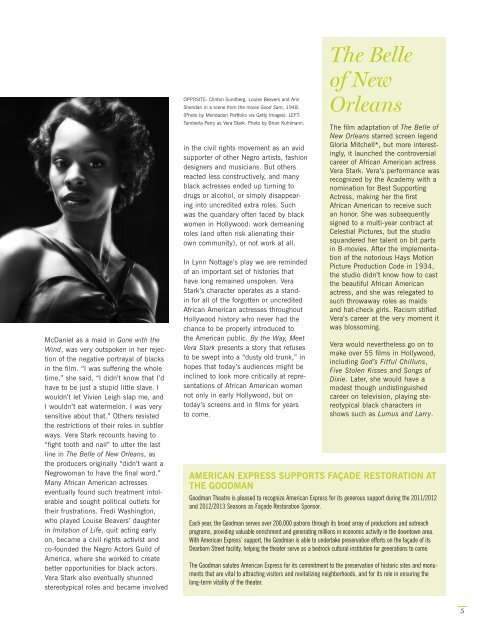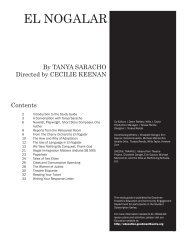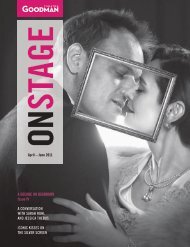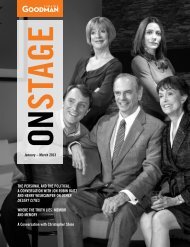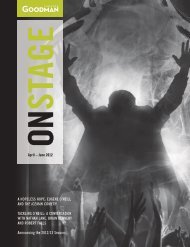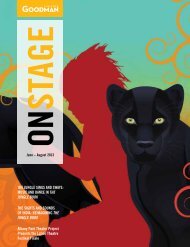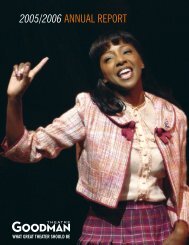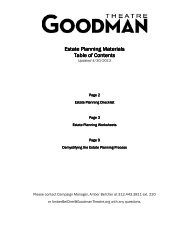BEYOND VERA STARK: HOLLYWOOD'S ... - Goodman Theatre
BEYOND VERA STARK: HOLLYWOOD'S ... - Goodman Theatre
BEYOND VERA STARK: HOLLYWOOD'S ... - Goodman Theatre
Create successful ePaper yourself
Turn your PDF publications into a flip-book with our unique Google optimized e-Paper software.
McDaniel as a maid in Gone with the<br />
Wind, was very outspoken in her rejection<br />
of the negative portrayal of blacks<br />
in the film. “I was suffering the whole<br />
time,” she said, “I didn’t know that I’d<br />
have to be just a stupid little slave. I<br />
wouldn’t let Vivien Leigh slap me, and<br />
I wouldn’t eat watermelon. I was very<br />
sensitive about that.” Others resisted<br />
the restrictions of their roles in subtler<br />
ways. Vera Stark recounts having to<br />
“fight tooth and nail” to utter the last<br />
line in The Belle of New Orleans, as<br />
the producers originally “didn’t want a<br />
Negrowoman to have the final word.”<br />
Many African American actresses<br />
eventually found such treatment intolerable<br />
and sought political outlets for<br />
their frustrations. Fredi Washington,<br />
who played Louise Beavers’ daughter<br />
in Imitation of Life, quit acting early<br />
on, became a civil rights activist and<br />
co-founded the Negro Actors Guild of<br />
America, where she worked to create<br />
better opportunities for black actors.<br />
Vera Stark also eventually shunned<br />
stereotypical roles and became involved<br />
OPPOSITE: Clinton Sundberg, Louise Beavers and Ann<br />
Sheridan in a scene from the movie Good Sam, 1948.<br />
(Photo by Mondadori Portfolio via Getty Images). LEFT:<br />
Tamberla Perry as Vera Stark. Photo by Brian Kuhlmann.<br />
in the civil rights movement as an avid<br />
supporter of other Negro artists, fashion<br />
designers and musicians. But others<br />
reacted less constructively, and many<br />
black actresses ended up turning to<br />
drugs or alcohol, or simply disappearing<br />
into uncredited extra roles. Such<br />
was the quandary often faced by black<br />
women in Hollywood: work demeaning<br />
roles (and often risk alienating their<br />
own community), or not work at all.<br />
In Lynn Nottage’s play we are reminded<br />
of an important set of histories that<br />
have long remained unspoken. Vera<br />
Stark’s character operates as a standin<br />
for all of the forgotten or uncredited<br />
African American actresses throughout<br />
Hollywood history who never had the<br />
chance to be properly introduced to<br />
the American public. By the Way, Meet<br />
Vera Stark presents a story that refuses<br />
to be swept into a “dusty old trunk,” in<br />
hopes that today’s audiences might be<br />
inclined to look more critically at representations<br />
of African American women<br />
not only in early Hollywood, but on<br />
today’s screens and in films for years<br />
to come.<br />
The Belle<br />
of New<br />
Orleans<br />
The film adaptation of The Belle of<br />
New Orleans starred screen legend<br />
Gloria Mitchell*, but more interestingly,<br />
it launched the controversial<br />
career of African American actress<br />
Vera Stark. Vera’s performance was<br />
recognized by the Academy with a<br />
nomination for Best Supporting<br />
Actress, making her the first<br />
African American to receive such<br />
an honor. She was subsequently<br />
signed to a multi-year contract at<br />
Celestial Pictures, but the studio<br />
squandered her talent on bit parts<br />
in B-movies. After the implementation<br />
of the notorious Hays Motion<br />
Picture Production Code in 1934,<br />
the studio didn’t know how to cast<br />
the beautiful African American<br />
actress, and she was relegated to<br />
such throwaway roles as maids<br />
and hat-check girls. Racism stifled<br />
Vera’s career at the very moment it<br />
was blossoming.<br />
Vera would nevertheless go on to<br />
make over 55 films in Hollywood,<br />
including God’s Fitful Chilluns,<br />
Five Stolen Kisses and Songs of<br />
Dixie. Later, she would have a<br />
modest though undistinguished<br />
career on television, playing stereotypical<br />
black characters in<br />
shows such as Lumus and Larry.<br />
AMERICAN EXPRESS SUPPORTS FAÇADE RESTORATION AT<br />
THE GOODMAN<br />
<strong>Goodman</strong> <strong>Theatre</strong> is pleased to recognize American Express for its generous support during the 2011/2012<br />
and 2012/2013 Seasons as Façade Restoration Sponsor.<br />
Each year, the <strong>Goodman</strong> serves over 200,000 patrons through its broad array of productions and outreach<br />
programs, providing valuable enrichment and generating millions in economic activity in the downtown area.<br />
With American Express’ support, the <strong>Goodman</strong> is able to undertake preservation efforts on the façade of its<br />
Dearborn Street facility, helping the theater serve as a bedrock cultural institution for generations to come.<br />
The <strong>Goodman</strong> salutes American Express for its commitment to the preservation of historic sites and monuments<br />
that are vital to attracting visitors and revitalizing neighborhoods, and for its role in ensuring the<br />
long-term vitality of the theater.<br />
5


